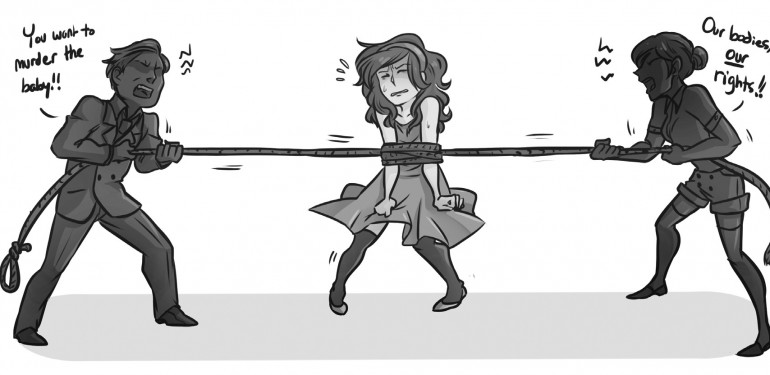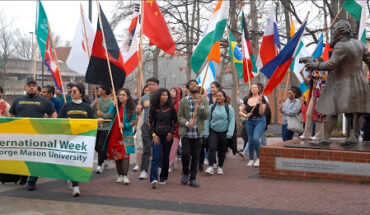The Genocide Awareness Project, a program that seeks to end abortion, staged a protest from Monday through Wednesday last week on SUB I Plaza.
“The two most important facts that we want to present are the humanity of the child from the moment of fertilization and the fact that abortion is an act of violence that ends the life of that unborn child,” said Maggie Egger, the project director for the Mason campus.
The protest stood out for its use of graphic images comparing abortion to genocide. Photographs of alleged bloody, aborted fetuses appeared alongside photos of the Holocaust, lynchings and the Rwandan genocide on both large billboards and smaller poster boards held by participants in front of Fenwick Library.
“Our organization does focus on using graphic images, because that’s the most effective way to tell people the truth about what abortion is and what the victim of abortion is,” Egger said.
She added that the images were professionally taken with the permission of an abortion doctor who let them into his clinic and verified the ages of the embryos and fetuses, which were displayed underneath the pictures.
“I’m always encouraged, when we do these graphic images on campus, when I see students respond with open minds,” said Anna Maher, president of GMU Students for Life, the organization that invited the Genocide Awareness Project to campus and helped organize the event.
Maher said that she hoped the images and the demonstration would encourage students to look at the realities of abortion and have a conversation about the topic.
“It’s critical that we begin developing programs that service outlets in which we can address these tensions that surround abortion, rather than just saying that abortion is so taboo, everyone disagrees on it, so let’s not even talk about it,” Maher said.
The Genocide Awareness Project is part of the Center for Bioethical Reform, a non-profit corporation that, according to their website, works to establish prenatal justice and the right to life for the unborn. The Genocide Awareness Project travels around college campuses across the nation and previously visited George Mason in 2003 and 2012.
Although the group visits other communities besides college campuses, Egger said that colleges allow them to reach out to people when they are at a very particular time in their lives.
“The vast majority of abortions are performed on college-age women, so that’s the ideal time to talk to them about this subject,” Egger said, citing students as important because of how many of them have to deal with abortion-related issues. “Also, the culture of a college campus is such that it really lends itself to this open debate…and being able to come out here and have both sides with very different viewpoints and have a great dialogue about it.”
On the other side of this dialogue is Elvira Razzano, a junior at Mason and an intern at the National Abortion and Reproductive Rights Action League Pro-Choice Virginia’s Campus Out Loud program. She organized a counter-protest to the Genocide Awareness Project’s activities through the organization, which she says is designed to get young people involved in pro-choice issues.
“I wanted [the Genocide Awareness Project] to see that there were students that were actively against what they were doing,” Razzano said. “I just wanted to create a sort of visibility for pro-choice students and just be like, hey, we’re at George Mason too and we don’t support this by any means.”
Though she does not know the exact number of people who turned out for the event, she says that approximately 20 people signed up ahead of time, and many others joined in throughout each of the three days. Protestors held handmade signs with slogans like “My Constitutional Rights Are NOT Up for Debate” and “Sick of Scare Tactics? Talk to Us!”
The demonstrations also opened the door for significant discussions about freedom of speech, particularly regarding the Genocide Awareness Project’s use of images some say they find disturbing.
After the group left campus, Honors College Living Learning Community Coordinator Kevin Stoy sent honors students an email announcing that his door was open to anyone who was disturbed by the images and needed to talk. He also directed students to related on-campus support facilities like Counseling and Psychological Services, the Office of Diversity, Inclusion and Multicultural Education, the Office of Compliance, Equity and Diversity and the Women and Gender Studies Center.
He said the email was prompted by both a sense of responsibility as an LLC coordinator and an alert sent to University Life administrators by Dr. Dennis Webster, one of the leaders of Mason’s Campus Climate Committee. The committee provides a Bias Incident Report Form for students to report acts of bias, intolerance and discrimination.
“Living Learning Coordinators like me are here to support Mason students, especially when the sense of community we’ve worked so hard to foster and maintain here on campus is disrupted or threatened by groups like the Genocide Awareness Project,” Stoy said.
According to John Davis, assistant professor of communication who teaches a course on free speech and ethics, the question of whether the Genocide Awareness Project’s use of graphic images disrupts the campus environment is key to determining how the university should treat it.
“It doesn’t have to be volume that constitutes disruption,” Davis said.
The possibility that the pictures might distract students from their work is a potential reason for the college to challenge the presence of the Genocide Awareness Project.
“When it affects a student walking to their classroom, maybe they had an abortion or maybe they’ve gone through something deep like that… they’re not going to get what they paid for as to why they’re on a college campus,” Davis said.
He notes that there have been laws set up to regulate the display of images like these. For instance, Planned Parenthood clinics have tried to move anti-abortion protests at least ta block away from the clinic itself to put some distance between them and the women visiting the clinics.
Still, Davis hesitates to suggest that Mason should place limits on any form of expression solely because it might prompt uncomfortable emotional reactions.
“More speech is better than less speech,” Davis said, “I don’t think it’s for a university or a society to start regulating the content of what people do. All they can regulate is how, the time, the place or the manner of how that protest or expression is done.”
The students protesting the Genocide Awareness Project said they were not looking to intrude on the group’s right to free speech.
“They do have their First Amendment rights to assemble and things like that, and I know there’s no way I could get them off campus, although I hate the message that they send,” Razzano said, adding that interactions between the two sides of the demonstration had maintained an overall civil, respectful tone.
However, she recalled that a group of students had signed a petition when the Genocide Awareness Project visited before in spring 2012, hoping to stop their use of the graphic images.
“They weren’t really protesting their presence, just saying that these images are triggering and that they’re harmful,” Razzano said.
Both pro-life and pro-choice student leaders agreed that their primary aims in holding the protests were to foster an on-campus conversation about abortion and to encourage greater student involvement in related issues and programs. To further this goal and give students a forum to discuss their thoughts on the Genocide Awareness Project and abortion, they arranged for a dialogue to take place Monday, March 31 at 5:30 p.m. in SUB I, meeting room 3A.
“We see each other as partners in a solution, in terms of the fact that we both want to help women, just in completely different ways,” Maher said.



